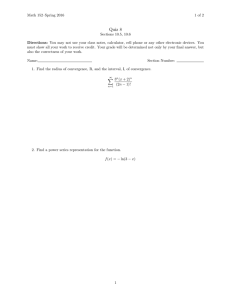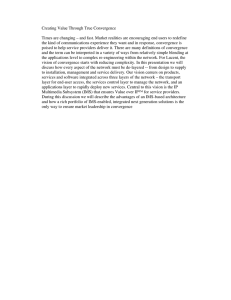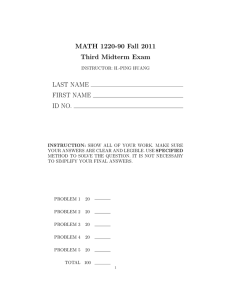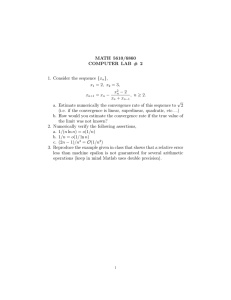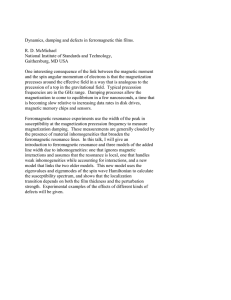Homogenization of ferromagnetic materials
advertisement
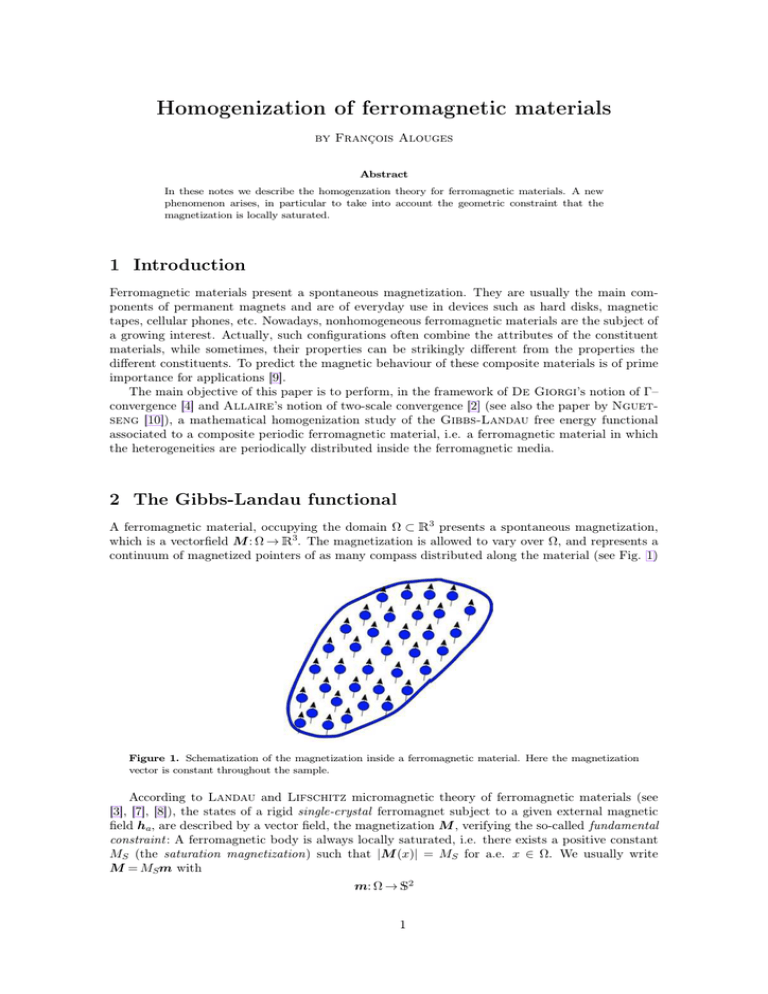
Homogenization of ferromagnetic materials
by François Alouges
Abstract
In these notes we describe the homogenzation theory for ferromagnetic materials. A new
phenomenon arises, in particular to take into account the geometric constraint that the
magnetization is locally saturated.
1 Introduction
Ferromagnetic materials present a spontaneous magnetization. They are usually the main components of permanent magnets and are of everyday use in devices such as hard disks, magnetic
tapes, cellular phones, etc. Nowadays, nonhomogeneous ferromagnetic materials are the subject of
a growing interest. Actually, such configurations often combine the attributes of the constituent
materials, while sometimes, their properties can be strikingly different from the properties the
different constituents. To predict the magnetic behaviour of these composite materials is of prime
importance for applications [9].
The main objective of this paper is to perform, in the framework of De Giorgi’s notion of Γ–
convergence [4] and Allaire’s notion of two-scale convergence [2] (see also the paper by Nguetseng [10]), a mathematical homogenization study of the Gibbs-Landau free energy functional
associated to a composite periodic ferromagnetic material, i.e. a ferromagnetic material in which
the heterogeneities are periodically distributed inside the ferromagnetic media.
2 The Gibbs-Landau functional
A ferromagnetic material, occupying the domain Ω ⊂ R3 presents a spontaneous magnetization,
which is a vectorfield M : Ω → R3. The magnetization is allowed to vary over Ω, and represents a
continuum of magnetized pointers of as many compass distributed along the material (see Fig. 1)
Figure 1. Schematization of the magnetization inside a ferromagnetic material. Here the magnetization
vector is constant throughout the sample.
According to Landau and Lifschitz micromagnetic theory of ferromagnetic materials (see
[3], [7], [8]), the states of a rigid single-crystal ferromagnet subject to a given external magnetic
field ha, are described by a vector field, the magnetization M , verifying the so-called fundamental
constraint : A ferromagnetic body is always locally saturated, i.e. there exists a positive constant
MS (the saturation magnetization) such that |M (x)| = MS for a.e. x ∈ Ω. We usually write
M = MSm with
m: Ω → S2
1
2
Section 3
where S2 denotes the unit sphere of R3.
Eventhough the magnitude of the magnetization vector is constant in space for a given material,
in general it is not the case for its direction, and the observable states can be mathematically
characterized as local minimizers of the Gibbs-Landau free energy functional associated to the
single-crystal ferromagnetic particle:
Z
Z
Z
Z
µ
aex|∇m|2 dµ +
hd[Msm] · Msmdµ −µ0 ha · Msmdµ .
ϕan(m) dµ − 0
GL(m)
2 Ω
Ω
Ω
Ω
8
=:E(m)
=:A(m)
=:W (m)
=:Z(m)
The first term, E(m), is called exchange energy, and penalizes spatial variations of m. The factor
aex in the term is a phenomenological positive material constant which summarizes the effect of
(usually very) short-range exchange interactions.
The second term, A(m), or the anisotropy energy, models the existence of preferred directions
for the magnetization (the so-called easy axes). The anisotropy energy density ϕan: S 2 → R+
is assumed to be a globally non-negative even and globally lipschitz continuous function, that
vanishes only on a finite set of unit vectors, the easy axes, and is a function that depends on the
crystallographic symmetry of the sample.
The third term, W(m), is called the magnetostatic self-energy, and is the energy due to the
(dipolar) magnetic field, also known in literature as the stray field, hd[m] generated by m. From
the mathematical point of view, assuming Ω to be open, bounded and with a Lipschitz boundary,
a given magnetization m ∈ L2(Ω, R3) generates the stray field hd[m] = ∇um where the potential
um solves:
∆um = −div (m ) in D ′(R3).
(1)
In (1) we have indicated with m the extension of m to R3 that vanishes outside Ω. Lax-Milgram
theorem guarantees that Eq.(1) possesses a unique solution in the Beppo-Levi space:
u(·)
BL(R3) = u ∈ D ′(R3) :
∈ L2(R3) and ∇u ∈ L2(R3, R3) .
(2)
1+|·|
Eventually, the fourth term Z(m), is called the interaction energy, and models the tendency of
a specimen to have its magnetization aligned with the external field ha, assumed to be unaffected
by variations of m.
The competition of those four terms explain most of the striking pictures of the magnetization
that ones can see in most ferromagnetic material [6], in particular the so-called domain structure,
that is large regions of uniform or slowly varying magnetization (the magnetic domains) separated
by very thin transition layers (the domain walls). However, and in a sake of simplification, we will
not consider the stray field energy nor the anisotropy term in what follows. Therefore we omit the
corresponding contributions A(m) and W(m) in the sequel.
3 Homogenization
Physically speaking, when considering a ferromagnetic body composed of different magnetic materials (i.e. a non single-crystal ferromagnet), the material functions aex, Ms and ϕan are no longer
constant on the region Ω occupied by the ferromagnet. Moreover one has to describe the local
interactions of two grains with different magnetic properties at their touching interface [1].
We hereafter assume the strong coupling assumption for which the direction of the magnetization does not jump through an interface between two different materials. We insist on the fact
that only the direction is continuous at an interface while the magnitude Ms is obviously not. The
natural mathematical setting for the problem becomes to consider that the magnetization direction
m ∈ H 1(Ω, S2), where the class of admissible maps we are interested in is defined as
H 1(Ω, S2)
8 {m ∈ H (Ω, R ) : m(x) ∈ S
1
3
2
for a.e. x ∈ Ω}.
Γ − Convergence
3
Figure 2. Schematization of a periodic ferromagnetic composite material. The periodization occurs at a
scale ε.
3.1 The Gibbs-Landau energy functional associated to a composite ferromagnetic material
We start by recalling the basic idea of the mathematical theory of periodic homogenization. As
illustrated in Fig. 2, this means that we can think of the material as being built up of small identical
cubes, the side length of which being called ε. Let Y = R3/Z3 ≃ [0, 1)3 be the periodic unit cube of
R3. We let for y ∈ Y , aex(y), Ms(y) be the periodic repetitions of the functions that describe how
the exchange constant aex, the saturation magnetization Ms and the anisotropy density energy
ϕan(y, m) vary over the representative cell Y (see Fig. 2). At every scale ε, the energy associated
to the ε-heterogeneous ferromagnet, will be given by the following generalized Gibbs-Landau
energy functional
Z
Z
GLε (m)
aex(x/ε)|∇m|2 dµ − µ0 ha · Ms(x/ε)mdµ .
(3)
8
Ω
Ω
=:Eε(m)
=:Zε(m)
The asymptotic Γ-convergence analysis of the family of functionals (GLε )ε∈R+ as ε tends to 0, is
the object of the present notes.
3.2 Setting of the problem
The main purpose of this paper is to analyze, by the means of both Γ-convergence and two-scale
convergence techniques, the asymptotic behaviour, as ε → 0, of the family of Gibbs-Landau free
energy functionals (GLε )ε∈R+ expressed by (3). Let us make the statement more precise. We consider
the unit sphere S2 of R3 and, for every s ∈ S2, the tangent space of S2 at a point s will be denoted
by Ts(S2).
For the energy densities appearing in the family (GLε )ε∈R+ we assume the following hypotheses:
H1. The exchange parameter aex is supposed to be a Q-periodic measurable function belonging
to L∞(Q) which is bounded from below and above by two positive constants cex > 0, Cex > 0,
i.e. 0 < cex 6 aex(y) 6 Cex for µ-a.e. y ∈ Q.
H2. The saturation magnetization Ms is supposed to be a Q-periodic non-negative measurable
function belonging to L∞(Q).
4 Γ − Convergence
The notion of Γ-convergence has been introduced, mainly by De Giorgi in order to give a
framework for the convergence of minimization problems. Roughly speaking, we consider a
family of minimization problems (and associated functionals Fn) defined on a metric space X
(in our case, we have simply X = H 1(Ω)) and try to find a limiting minimization problem
(associated to the functional F∞) such that
88
in a suitable sense.
lim
min Fn(x) = min F∞(x) ′′
n→+∞ x∈X
x∈X
4
Section 4
4.1 Γ-convergence of a family of functionals
We start by recalling De Giorgi’s notion of Γ-convergence and some of its basic properties (see [4,
5]). Although, this is much more general than what wa use in these notes, we restrict our attention
to the case where the functionals are defined on H 1(Ω), and the notion of convergence is the weak
one.
Definition 1. (Γ-convergence of a sequence of functionals) Let (Fn)n∈N be a sequence of functionals defined on H 1(Ω) with values on R . The functional F : H 1(Ω) → R is said to be the Γ-limit
of (Fn)n∈N with respect to the weak convergence, if for every m ∈ H 1(Ω) we have:
∀(mn) ∈ (H 1(Ω))N, mn ⇀ m ⇒ liminf Fn(mn) > F (m)
(4)
∃(m̄n) ∈ (H 1(Ω))N, m̄n ⇀ m and F (m) = lim Fn(m̄n).
(5)
n→∞
and
n→∞
In this case we write
F = Γ- lim Fn.
(6)
n→∞
The condition ( 5) is sometimes referred in literature as the existence of a recovery sequence.
Definition 2. (Γ-convergence of a family of functionals) Let (Fε)ε∈R+ be a family of functionals
defined on H 1(Ω) with values on R . The functional F : H 1(Ω) → R is said to be the Γ-limit of
(Fε)ε∈R+ with respect to the weak topology, as ε → 0, if for every εn ↓ 0
(7)
F = Γ- lim Fεn.
n→∞
In this case we write F = Γ-limε→0Fε.
One of the most important properties of Γ-convergence, and the reason why this kind of variational convergence is so important in the asymptotic analysis of variational problems, is that under
appropriate compactness hypotheses it implies the convergence of (almost) minimizers of a family
of functionals to the minimum of the limiting functional. More precisely, the following result holds.
Theorem 3. (Fundamental Theorem of Γ-convergence) If (Fε)ε∈R+ is a family of functionals
which Γ-converges on H 1(Ω) to the functional F. Assume (mε)ε>0 is a family of minimizers for
(Fε)ε∈R+ respectively. Assume that mε ⇀ m0 as ε ⇀ 0, then m0 is a minimizer of F and
F (m0) =
min F (m) = lim Fε(mε) = lim
m∈H 1(Ω)
ε→0
min
ε→0 m∈H 1(Ω)
Fε(m).
(8)
Proof. We already know (from the first statement of Γ-convergence) that
liminf Fε(mε) > F (m0)
ε→0
1
Now, for any n0 ∈ H (Ω), we know that there exists a sequence (nε)ε>0 such that nε ⇀ n0 and
limε→0 Fε(nε) = F (n0). Using the fact that mε is a minimizer of Fε, we get
F (n0) = lim Fε(nε) > limsup Fε(mε) > iminfε→0 Fε(mε) > F (m0),
ε→0
ε→0
and therefore m0 is a minimizer for F . Eventually, taking n0 = m0 leads to the fact that all
inequalities are in fact equalities, and the result.
4.2 Γ-convergence and homogenization
We describe here the Γ-convergence method applied to the model problem. We consider, as usual,
a rigidity matrix A(y) which is Y -periodic (we still denote by Y = (0, 1)d the unit cell). For any
ε > 0, we call
Z
Z
x
1
∇u(x) · ∇u(x) dx −
A
f (x)u(x) dx ,
Fε(u) =
ε
2 Ω
Ω
Γ − Convergence
5
and we work in H01(Ω) (instead of H 1(Ω) as we have mentionned until now).
We also denote by
Z
Z
1
Ā ∇u(x) · ∇u(x) dx −
f (x)u(x) dx ,
F0(u) =
2 Ω
Ω
where Ā is he homogenized rigidity tensor. The aim of this part is to show the following theorem:
Theorem 4. The family (Fε)ε>0 Γ-converges to F0 in H01(Ω) for the weak topology.
Proof. We show the two properties of the Γ-convergence definition.
•
Let u0 ∈ H01(Ω), and a family (uε)ε>0 such that uε ⇀ u0 in H01(Ω). Then we know that
(uε)ε>0 is bounded in H01(Ω), and we have
uε → u0 strongly in L2(Ω),
uε ։ u0 two − scale in L2(Ω × Y ),
∇uε ։ ∇xu0(x) + ∇ yu1(x, y) two − scale in L2(Ω × Y ).
R
R
This is sufficient to deduce that Ω f (x)uε(x) d x→ Ω f (x)u0(x) d x as ε → 0. Now,
expanding the inequality
Z
x
x
x
A
∇uε(x) − ∇u0(x) − ∇ yu1 x,
· ∇uε(x) − ∇u0(x) − ∇ yu1 x,
dx ≥ 0,
ε
ε
ε
Ω
and passing to the liminf as ε → 0 leads to
Z
Z
x
A
liminf
∇uε(x) · ∇uε(x) ≥
A(y)(∇xu0 + ∇ yu1) · (∇xu0 + ∇ yu1) dxdy .
ε
ε→0
Ω
Ω×Y
Notice that strictly speaking this result is not true. We need indeed more regularity in u1
to be able to pass to the limit. We omit the rigorous details here and comment a little bit
afterwards.
Nevertheless, minimizing this latter expression in u1 leads to the fact that u1 solves the
cell problem (associated to u0) and
Z
Z
x
A
liminf
∇uε(x) · ∇uε(x) ≥ Ā ∇u0(x) · ∇u0(x) dx.
ε
ε→0
Ω
Ω
Putting this together with the continuity of the linear term leads to
Z
Z
Z
Z
x
1
1
A
Ā ∇u0(x) · ∇u0(x) −
f (x)u0(x)
liminf
∇uε(x) · ∇uε(x) −
f (x)uε(x) ≥
ε
2 Ω
ε→0 2 Ω
Ω
Ω
which is the desired result.
•
In order to show the second statement of Γ-convergence, for any u0 ∈ H02(Ω), one constructs
P
∂u
u1 by solving the cell problem, that is to say u1(x, y) = di=1 ωi(y) ∂x0 (x) where ωi are the
i
x
correctors, and then we consider uε(x) = u0(x) + εu1 x, ε . It is easy to show (and left to
the reader) that
uε → uZ0 strongly (and thus weakly)
in H01Z,
Z
Z
x
1
1
A
Ā ∇u0 · ∇u0 −
fu0 .
lim
∇uε · ∇uε −
fuε =
ε
2 Ω
ε→0 2 Ω
Ω
Ω
This shows the second statement of the Γ-convergence, and finishes the proof.
•
Notice that in order to prove both statements of Γ − convergence, we have been forced to
assume more regularity on the limits than required. In the first step, the limit of the term
which involves u0 and u1 requires a little bit of smoothness and in the second step, u0
is assumed to have H 2 regularity. This latter assumption is not really problematic since
redoing the proof of the convergence of minimizers in this context, we obtain
F (n0) > F (m0),
6
Section 5
with n0 in a dense subspace (here H 2) of H 1. however, since F is continuous in H 1, we have
the desired result (F (n0) > F (m0) ∀n0 ∈ H 1) by density.
Remark 5. Notice that in the preceding proof, we never assumed that u0 (resp. uε) was a
minimizer of F0 (resp. Fε).
5 Application to micromagnetics
The aim of this part is to apply the Γ-convergnce technique to the Gibbs-Landau functional. Before
doing so, we see that the unit norm constraint leads to a new cell problem.
5.1 Preliminaries
The first question that we would like to answer is whether the constraint |m| = 1 a.e. leads to some
new ingredients in the preceding proofs. Actually, we already know that if a family (mε)ε>0 is
bounded in H 1, then we can extract a subfamily (mε′ )ε which converges to m0 weakly in H 1 (and
strongly in L2 and a.e.). Expanding (formally) mε′ in a multiscale expansion, we get
x
+ O(ε2)
mε′ (x) = m0(x) + εm1 x,
ε
where m0 is the weak H 1 limit, and m1 is another map. Still formally, the second term εm1 has
to be understood as a perturbation to the first. Thus making an expansion (in ε) of |mε′ | = 1 leads to
which leads to the fact that
|m
= 1 (order 0)
0(x)|
x
= 0 (order 1)
2m0(x) · m1 x,
ε
∀x ∈ Ω, ∀y ∈ Y , m1(x, y) · m0(x) = 0.
Therefore, there is a hidden constraint that the corrector must be orthogonal to m0. We now turn
to the justification of this.
Proposition 6. Let (mε)ε>0 a family in H 1(Ω, S2) which is bounded in H 1. Then there exist
1
m0 ∈ H 1(Ω, S2), and m1 ∈ L2(Ω; H#
(Y )) such that ∀x ∈ Ω, m1(x, y) ⊥ m0(x) a.e. y ∈ Y, and up to
the extraction of a subfamily, one has
mε(x) ։ m0(x) two − scale,
∇mε(x) ։ ∇xm0(x) + ∇ ym1(x, y) two − scale.
Proof. We already know by the application of the classical two-scale result that up to the extraction of a subfamily, there exist m0 and m1 such that
mε(x) ։ m0(x) two − scale,
∇mε(x) ։ ∇xm0(x) + ∇ ym1(x, y) two − scale.
We just need to show that |m0(x)| = 1 a.e. x ∈ Ω and ∀x ∈ Ω, m1(x, y) ⊥ m0(x) a.e. y ∈ Y .
For the former, we also know that mε ⇀ m0 in H 1 weakly, and strongly in L2. Up to another
extraction of a subfamily, we can thus further assume that mε(x) → m0(x) for a.e. x ∈ Ω. Since
|mε(x)| = 1 a.e., we deduce that |m0(x)| = 1 a.e. x ∈ Ω. Now, we consider for φ ∈ C ∞(Ω × Y ) the
quantity
Z
x
∂mε
(x) dx.
Iε =
φ x,
(mε(x) − m0(x)) ·
ε
∂xi
Ω
Since mε − m0 → 0 strongly in L2 and
∂mε
(x)
∂xi
is bounded in L2, we know that
lim Iε = 0.
ε→0
7
Application to micromagnetics
∂m
On the other hand, since |mε(x)| = 1 a.e., we also know that mε(x) · ∂x ε (x) = 0 a.e. x ∈ Ω. Thus,
i
expanding Iε and passing to the 2-scale convergence, we get
Z
∂m0
∂m1
(x) +
(x, y) · m0(x)φ(x, y) dxdy =0.
∂xi
∂yi
Ω×Y
Now, using that m0(x) ·
∂m0
(x) = 0
∂xi
Z
Ω×Y
a.e. x ∈ Ω, we obtain
∂(m1(x, y) · m0(x))
φ(x, y) dxdy =0,
∂yi
R
which implies that m1(x, y) · m0(x) does not depend on y. Since moreover Y m1(x, y) dy=0 a.e.
x ∈ Ω, we obtain that m1(x, y) · m0(x)=0 for a.e. y ∈ Y , and furthermore a.e. x ∈ Ω.
5.2 Γ − convergence of the micromagnetic functional
The main result of these notes is the following.
Theorem 7. Let (GLε )ε∈R+ be a family of Gibbs-Landau free energy functionals satisfying (H1)
and (H2). The family (GLε )ε∈R+ Γ-converges in (H 1(Ω, S 2)) for the weak convergence to the
functional Ghom: H 1(Ω, S 2) → R+ defined by
Ghom(m)
8E
hom(m) −
where
Ehom(m)
8
Z
µ0Zhom(m)
(9)
ā |∇m|2,
Ω
(here ā Id is the classical homogenized tensor) and where the homogenized interaction energy is
given by
Z
Zhom(m) = hMs iY ha · mdµ.
Ω
Proof. We have to prove both statements of Γ- convergence. Namely we consider m0 ∈ H 1(Ω),
and a family mε ∈ H 1(Ω, S2) which is such that mε ⇀ m0 in H 1(Ω). As before, we know from this
that up to the extraction of a subfamily, one can assume that
mε
mε
mε
∇mε
→
→
։
։
m0 strongly in L2(Ω),
m0 a.e. in Ω,
m0 two − scale in L2(Ω × Y ),
∇xm0(x) + ∇ ym1(x, y) two − scale in L2(Ω × Y ).
We also know that m0 only depends on x while from the a.e. convergence, we easily deduce that
m0 ∈ H 1(Ω, S2).
Now, let us consider the second term Zε(m). We have
Z
Zε(m) =
ha · Ms(x/ε)mε(x)dx
Ω Z
= ha ·
Ms(x/ε)mε(x) dx
ZΩ Z
→ ha ·
Ms(y)m0(x) dxdy
Ω
Y
as ε → 0 from the 2-scale convergence. Then we remark that
Z
Z Z
ha ·
Ms(y)m0(x) dxdy = hMs iY ha · m0 dx = Zhom(m0) .
Ω
Y
Ω
Therefore the second term is continuous with respect to weak H 1 convergence. As far as the first
term is concerned, we have the following lemma whose proof is postponed.
8
Section 5
R
x
Lemma 8. Let Fε(m) = Ω A ε ∇m(x) · ∇m(x)dx. Then (Fε)ε Γ-converges in H 1 for the weak
R
H 1 convergence to F0(m) = Ω Ahom(m)∇m(x) · ∇m(x)dx where Ahom(m) is given by
Z
A(y)(ξ + ∇ψ(y)) · (ξ + ∇ψ(y))dy .
Ahom(m)ξ · ξ =
min
1
ψ ∈H#
(Y ,m⊥)
Y
Assuming the lemma for the time being, we get from a direct application that (Eε)ε Γ-converges
in H 1 for the weak H 1 convergence to E0 defined by
Z
E0(m) =
ahom(m)|∇m(x)|2dx ,
Ω
where
ahom(m)|ξ |2 =
min
1
ψ ∈H#
(Y ,m⊥)
Z
a(y)|ξ + ∇ψ(y)|2dy .
Y
In order to get the theorem, we just need to show that actually this homogenized coefficient does
not depend on m and is equal to the classical homogenized coefficient. This is simply seen by
expanding the preceding formula in terms of coefficients. Indeed, it is not restrictive to assume that
m = ez = (0, 0, 1) is the vertical unit vector (by applying a global rotation to the formula), and we get
ahom(m)|ξ |2 = ahom(e3)|ξ ′|2Z
=
=
a(y)|ξ ′ + ∇ψ(y)|2dy
min
1
ψ ∈H#
(Y ,e⊥
z)
min
Y
Z
1
ψ1,ψ2 ∈H#
(Y ) Y
′ 2
ā (|ξ1| + |ξ2′ |2)
′2
a(y)(|ξ1′ + ∇ψ1(y)|2 + |ξ2′ + ∇ψ2(y)|2)dy
=
= ā |ξ |
= ā |ξ |2 .
Therefore E0(m) =
R
Ω
ā |∇m(x)|2dx , which is the desired result.
In order to finish the proof, we need to prove Lemma 8.
Proof. (Lemma 8). Let m0 ∈ H 1(Ω), and a family mε ∈ H 1(Ω, S2) which is such that mε ⇀ m0 in
H 1(Ω). As before, we know from this that up to the extraction of a subfamily, one can assume that
mε
mε
mε
∇mε
→
→
։
։
m0 strongly in L2(Ω),
m0 a.e. in Ω,
m0 two − scale in L2(Ω × Y ),
∇xm0(x) + ∇ ym1(x, y) two − scale in L2(Ω × Y ).
We also know that m0 only depends on x while from the a.e. convergence, we easily deduce that
m0 ∈ H 1(Ω, S2). Moreover, an application of proposition 6 also gives that m1(x, y) · m0(x) = 0 for
all x ∈ Ω and all y ∈ Y . Now, applying the technique of proof of the preceding case (without the
constraint), we get
Z
Z
x
A
liminf
∇mε(x) · ∇mε(x) ≥
A(y)(∇xm0 + ∇ ym1) · (∇xm0 + ∇ ym1) dxdy
ε
ε→0
Ω
Ω×Y Z
A(y)(∇xm0 + ∇ yφ) · (∇xm0 + ∇ yφ) dxdy
≥ min
φ·m0 =0 Ω×Y
Z
≥
Ahom(m0)∇xm0 · ∇xm0 dx
Ω
by the definition of Ahom(m). This proves the first statement of Γ-convergence. For the second
statement, we have to build a special family (mε)ε that converges weakly to m0 and such that
Z
Z
x
∇mε(x) · ∇mε(x) =
Ahom(m0)∇xm0 · ∇xm0 dx.
lim
A
ε
ε→0 Ω
Ω
9
Bibliography
As before, we consider m1 solution to the cell problem, namely
Z
m1(x, ·) = argmin φ·m0 =0 A(y)(∇xm0(x) + ∇ yφ(x, y)) · (∇xm0(x) + ∇ yφ(x, y)) dy .
Y
We then build the family
mε(x) = m0(x) + εm1 x,
m0(x) + εm1 x,
x
ε
x ε
.
x
If m0 ∈ H 2, it is easily seen that mε ∈ H 1(Ω, S2), and mε(x) = m0(x) + εm1 x, ε + O(ε2) in H 1.
Therefore,
Z
Z
x
x
x
A
∇mε(x) · ∇mε(x) =
∇xm0 + ∇ ym1 x,
· ∇xm0 + ∇ ym1 x,
A
ε
ε
ε
Ω
Ω
x
dx+O(ε)
Zε
→
A(y)(∇xm0 + ∇ ym1) · (∇xm0 + ∇ ym1) dxdy
Ω×Y
as ε→ 0 by two-scale convergence. A direct computation shows that this latter expression is equal to
Z
Ahom(m0)∇xm0 · ∇xm0 dx
Ω
which concludes the proof.
6 Conclusion
In these notes, we have described an application of Γ-convergence applied to the periodic homogenization of the Gibbs-Landau functional which modelizes the behavior of ferromagnetic materials.
Compared to the classical theory, we notice that two major difficulties have to be overcome:
•
The geometric constraint the the magnetization is of constant magnitude almost everywhere
throughout the sample leads to a cell problem which now depends also on the value of m0
the two-scale limit, and not only on its gradient. As we have already remarked, this is a
general fact when such constraints need to be handled on the unknown (typically, to belong
to a manifold);
•
The convergence is understood in terms of convergence of variational problems. The good
framework for this kind of convergence is the so-called Γ-convergence theory of De Giorgi.
Although some difficulties appear, the classical homogenization program can be performed and a
homogenized functional (when the scale of the periodic structure tends to 0) can be shown to be
the Γ-limit of the Gibbs-Landau functional.
Bibliography
[1] E. Acerbi, I. Fonseca and G. Mingione. Proc. R. Soc., 462:0, 2006.
[2] G. Allaire. Homogenization and two-scale convergence. SIAM J. Math. Anal., 23(6):0, 1992.
[3] W. F. Brown. The fundamental theorem of the theory of fine ferromagnetic particles. J. Appl. Phys., 39:0, 1968.
[4] E. De Giorgi and T. Franzoni. Su un tipo di convergenza variazionale. Atti Accad. Naz. Lincei Rend. Cl. Sci.
Fis. Mat. Natur. , 58(8):0, 1975.
[5] G. Dal Maso. An introduction to Γ-convergence. Progress in Nonlinear Differential Equations and their Applications. Birkhauser Boston, 1993.
[6] A. Hubert and R. Schaefer. Magnetic Domains: The Analysis of Magnetic Microstructures. Springer, 1998.
[7] L. Landau and E. Lifshitz. Phys. Z. Sowjetunion, 169(14):0, 1935.
[8] Serpico C. Mayergoyz I.D., Bertotti G. Nonlinear magnetization dynamics in nanosystems. Elsevier, 2008.
[9] G. W. Milton. The Theory of Composites. Cambridge Monographs on Applied and Computational Mathematics. Cambridge University Press, 2002.
[10] G. Nguetseng. A general convergence result for a functional related to the theory of homogenization. SIAM
J. Math. Anal., 20(3):0, 1989.

